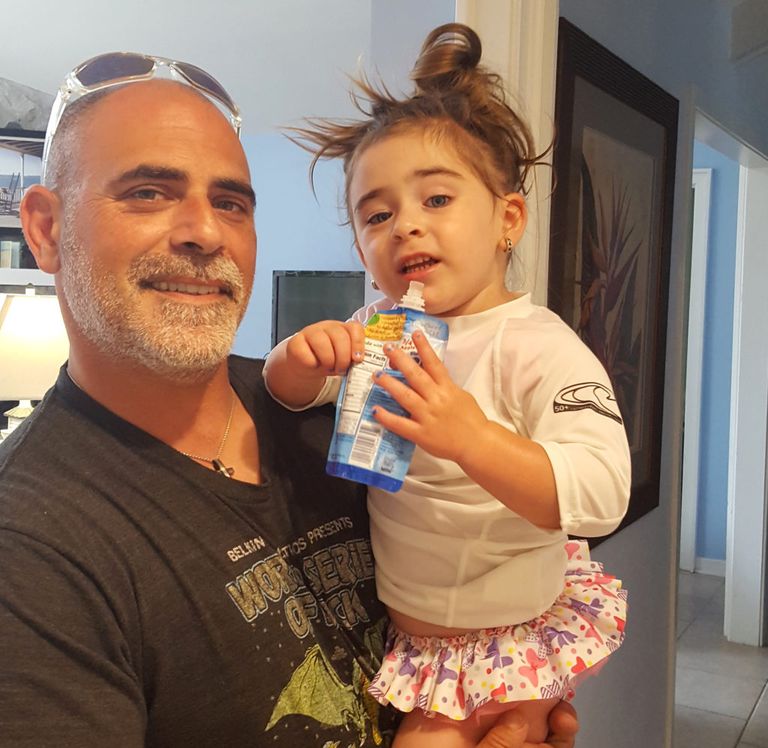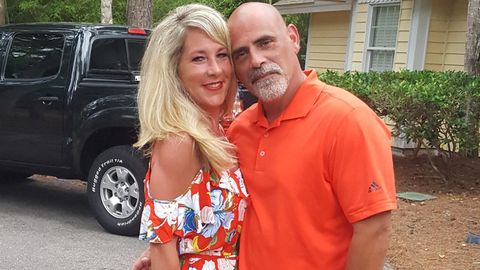

When Al Sidoti got divorced from his first wife, it took a while for him to put the pieces of his life back together. “I was going to the gym once a week, then twice a week, then 11 times a week,” Sidoti, a then-35-year-old plumber, told MensHealth.com. “I was losing weight. I started dating. Life was good.”
Eventually, however, he started to feel pain in his abdomen. Then he started noticing blood in his urine towards the end of the stream.
At first, “I just thought it was some kind of fluke,” says Sidoti. So he decided to go to the doctor, who thought he had pulled or over-stretched a muscle from working out. He was told to stop his workout routine. But the pain persisted — and became worse.
Sidoti’s doctor sent him to a urologist. “I was given a prostate exam, and everything was OK. Then he whips out a scope and has me lie down, gets me numbed up, and inserts it into my urethra. The pain was outrageous…no man ever wants that done,” says Sidoti.
What the doctor found wasn’t good.
“He looked around and asked if I came alone, and if I wanted to call anybody. I knew what he was about to tell me was bad,” says Sidoti. “He drew up pictures and says ‘You have bladder cancer.’ They said it looked like seaweed at the bottom of the ocean floor, and was growing outside of the bladder. We needed to start treating it right away.”
Sidoti didn’t know at the time that bladder cancer is one of the most deadly cancers. In 2018, 62,380 men will be diagnosed bladder cancer, and out of those, 12,520 will die, according to the American Cancer Society. Although Sidoti was only 35 when he was diagnosed, it’s much more common in older men: in fact, 9 out of 10 men diagnosed are over the age of 55. The most common symptoms include frequent urination, a tingling or burning when peeing, and blood in your urine.
“The pain was outrageous.”
Sidoti didn’t know at the time that bladder cancer is one of the most deadly cancers. In 2018, 62,380 men will be diagnosed bladder cancer, and out of those, 12,520 will die, according to the American Cancer Society.
Although Sidoti was only 35 when he was diagnosed, it’s much more common in older men: in fact, 9 out of 10 men diagnosed are over the age of 55. The most common symptoms include frequent urination, a tingling or burning when peeing, and blood in your urine.
Sidoti’s treatment plan began with Bacillus Calmette-Guerin injections, which creates an inflammatory response in the bladder to try to prevent the cancer from returning. He also underwent multiple surgeries to have the cancer manually removed. It didn’t work. “It kept coming back after I had it done 2-3 times,” says Sidoti.
His urologist sent him to the Cleveland Clinic, where they performed a blue light cystoscopy, a procedure that shows high and low-risk bladder cancer tumors under a blue light. The doctors found the cancer was spreading outside the bladder walls.
Sidoti’s urologist, Georges-Pascal Haber, MD, PhD, sat down with Sidoti and his soon-to-be fiancee, Dawn. “He told me that if the cancer continued to spread, it would move towards my major organs: the kidneys, liver, and my lymph nodes. That would have been a death sentence,” says Sidoti.
The next move was a decision to perform a minimally-invasive robotic surgery to completely remove Sidoti’s bladder, followed by a surgery to reconstruct a new bladder using his small intestine. While this surgery was relatively new, a 2018 study found that it reduced surgery time, improved recovery time, and reduced blood loss.
But there was one big caveat: the surgery would also require Sidoti’s prostate to be removed. This meant that without preserving his sperm, he could never become a father.
This was devastating to Sidoti. “I’m from a big Sicilian family,” he says. “I always wanted a lot of kids.” To make matters worse, at the time, Sidoti was preparing to propose to his girlfriend, Dawn, who also wanted to start a family.

Al Sidoti
Sidoti started going to the Cleveland Clinic’s sperm bank a few times a week to save it for a possible future intrauterine insemination (IUI) or in vitro fertilization (IVF). With his chances of becoming a father preserved, he was ready for the operation.
It took 10-12 hours to remove Sidoti’s bladder and construct a new one out of his small intestine. Haber created a softball-sized bladder that was attached to Sidoti’s kidneys and urethra.
Sidoti’s recovery lasted seven long months. He had to wait six months to have sex, and he had to re-learn how to pee. “I had to constantly irrigate my new plumbing by pumping saline in and out of a catheter. But the bladder was closing up due to scar tissue, which was preventing me from peeing normally,” says Sidoti.
He had to learn how to use his Kegel muscles (the muscles that form the pelvic floor) to push his urine out. “I was a plumber who needed new plumbing,” he says of the post-surgery recovery period, laughing at the irony of the situation.
Eventually, however, Sidoti learned to work with his new plumbing. And after a few tries, Sidoti and his wife Dawn welcomed a daughter in 2013.

Al Sidoti
Now 42 and cancer-free, Sidoti’s lifestyle has remained pretty much the same. But there have been a few changes. He wakes up a few times every night to pee, and he avoids coffee, a known diuretic. “I have to watch how much I drink. If I drink too much, it expands my small intestine, making it harder to push out fluids with my Kegels,” says Sidoti. “My urine is thicker, since the small intestine wants to make mucus.”
But he is grateful to be alive and free of a urostomy bag.
“I was the youngest patient Dr. Haber ever did this operation on. But he saved my life and helped give me my daughter. My life is good,” he says.
Source: Read Full Article